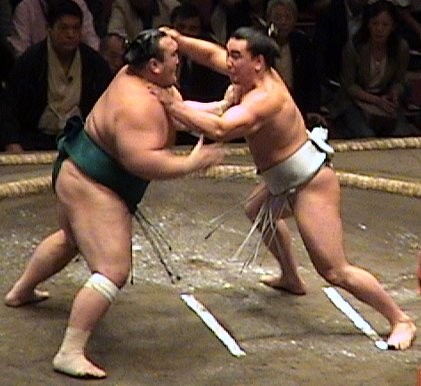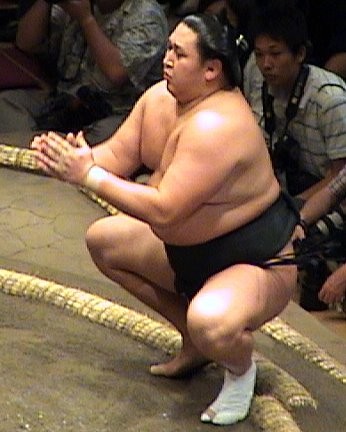|


|
SOS - Shinjinrui on Sumo |

|
Chris Gould
Chris sinks his teeth into how sumo can go about pulling in the younger
fans - currently so noticeable by their absence. The first of a
three-part series.
|
|
|
Sumo World Championships |

|
Mark Buckton
Mark Buckton reports from Sakai near Osaka, site of the latest Sumo World Championships.
|
|
|
Rikishi of Old |


|
Joe Kuroda
Joe Kuroda finishes off his look at former yokozuna Minanogawa.
|
|
|
Sumo 101 / Eric Evaluates |

|
Eric Blair
Eric expains sumo fan terminology - with the inevitable twist - for
those just getting into the sport and still subject to the know it alls.
|
|
|
Age stands still for no man |

|
Joe Kuroda
Former ozeki Kiyokuni will retire in November under the compulsory '65
and you are out' rule. JK takes a look at this quiet earth mover.
|
|
|
Feel the Sumo |



|
Eduardo de Paz
Read and feel the renowned Leonishiki's passion for all things sumo at his first live event.
|
|
|
SFM Interview |

|
Mark Buckton
Mark interviews Colin Carroll - again - Irish star of Sakai.
|
|
|
Photo Bonanza |

|
See the Aki Basho bonanza as well as the largest collection of pics you
are likely to see on the Sumo World Championships earlier in October.
|
|
|
Aki Basho Summary |


|
Lon Howard
Lon wraps the September Aki Basho and throws in some henka sighting results for good measure.
|
|
|
Lower Division Rikishi |


|
Mikko Mattila
The lower divisions, their members and results get the once over thanks to Mikko's eye of things 'beneath the curtain'.
|
|
|
|
|
Kimarite Focus |



|
Mikko Mattila
Mikko's latest clarification of several of the sport's plethora of kimarite.
|
|
|
Amateur Angles |


|
Howard Gilbert
Howard Gilbert - manager of New Zealand's amateur sumo team takes a look at the approaching Russians.
|
|
|
Kokugi Konnections |


|
Todd Lambert
Click on Todd's bimonthly focus on three of the best sumo sites online.
|
|
|
Fan Debate |

|
Facilitator - Lon Howard
Jesse Lake and Rich Pardoe hammer out their differences on a current furor - promotion criteria.
|
|
|
SFM Cartoons |
|
Benny Loh & Stephen Thompson
In this issue's cartoon bonanza, sit back and enjoy Benny Loh's
offerings and put a caption to Stephen Thompson's picture to win
yourselves a banzuke.
|
|
|
Sumo Odds ’n’ Ends |
|
SFM's interactive elements including Henka Sightings, Elevator Rikishi and Eternal Banzuke!
|
|
|
|
|
Readers' Letters |

|
See what our readers had to say since we last hit your screens.
|
|
|
Sumo Quiz |
|
The Quizmaster
Answer the Qs and win yourself next basho’s banzuke.
|
|
|
 |
|
is several spots higher than the M6 he was at this
time, and watching him “out-mawashi” the behemoth Baruto on day 9 was
one of the few points of light in the basho.

Iwakiyama and Ama
I don’t know what’s been going on with M5 Iwakiyama lately, but it was
surprising and refreshing to see him pound his way back to the joi-jin
with a solid 10-5 performance. Some of his tachiai were literally
brutal – in the positive sense. Getting his eight wins next time
in the meatgrinder will be much tougher, but if it does happen, the
competition among the ozeki hopefuls will get revved up in a
hurry. For now though – good for him.
Something positive on the list was actually a 7-8 make-koshi by M2
Tokitenku. By going 3-6 against the sanyaku and otherwise facing
only the top of the maegashira men, his joi-jin application is hereby
approved. His constant trips and pulls are hindrances, in my
view, but he’s so good with them, I’m tempted not to argue with the
result. I guess he is what he is, which is more than most.
In comparing the two men at M7, you’d think Kotoshogiku’s 10-5 would
trump Futeno’s 9-6, until you compared the opponents they
defeated. The only rikishi above M9 that Kotoshogiku bested was
Toyonoshima, who was way out of his element at M6. In that same
grouping,Futeno downed Dejima, Kyokutenho and Tochinonada, as well as
Kotoshogiku in their head-to-head. It was mentioned that
Kotoshogiku suffered foot and thumb
|
 |

|

|
Kotoshogiku
injuries during the basho, but they didn’t appear to be factors for him.
It is now apparent that you can group, in M8, Kakizoe with Kotoshogiku
and others who can clean up against the bottom of the division but who
are overmatched when faced with those above M7 or so. Kakizoe’s
9-6 included losses against all five higher-ranked opponents he
faced. M10 Takekaze’s recent marriage seemed not to affect his
sumo for better or worse, as his 10-5 outing was about what was
expected at this rank. A kachi-koshi at his higher rank in Kyushu
would be a sign of real progress for him – without that though, it’s
back on the elevator.
The only other kachi-koshi in Aki were from M13 Hokutoriki at 10-5, and
from M15 Kasugao at 8-7. That’s okay for Hokutoriki at this
level, but if it’s all he can do, it might be a sign that the rest of
the division is finding more ways to adjust to his lean
skill-set. It’s been 15 basho since he’s posted more than eight
wins at a rank above M11. With Kasugao, all you can say is that
he barely saved his makuuchi scalp, so it’s hang-on time again for him
in Kyushu.
On the make-koshi side of things,
|

|

|

|
there
wasn’t a single performance one could characterize as
disappointing. All of them were entirely reasonable, when
considering the men and their ranks; so let’s start with M2 Tamanoshima
and his 4-11 offering. Last year, in reviewing the 2005 Nagoya
basho, I grouped him with five other rikishi that I had written off, as
far as achieving higher goals is concerned – the others being Kaio,
Tochiazuma, Wakanosato, Kotomitsuki and Miyabiyama. There were
close calls with Tochiazuma and Miyabiyama, but so far I’m six for six,
and this just might be the very last time that anyone could say that
Tamanoshima disappointed them. In auto lingo, you could call him
a pricier version of the Kasugao – a wide array of features there but
mysteriously, no real performance. Maybe someone closer to the
scene can offer a clue – a training or psychological failing or
something – I don’t know, but in terms of further hope, nothing
remains.
I guess the 6-9 posting of M4 Kyokutenho could be called disappointing
since it will probably send him down to his lowest rank in four years,
but he’s shown recent signs of lethargy and even disinterest, so it
didn’t surprise me.

Kyokutenho
The same could be said of his fellow Mongolian heya-mate, M8 Kyokushuzan, who laid down his own 6-9 mark without much of a
Next
|
|







